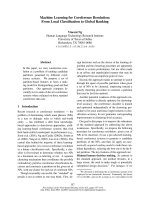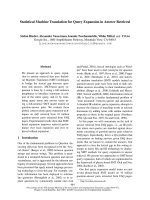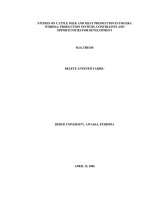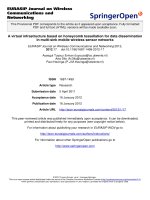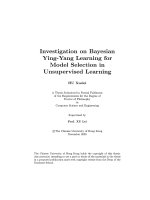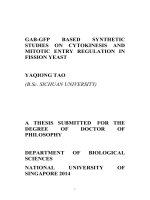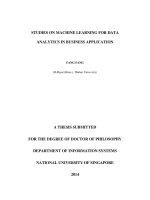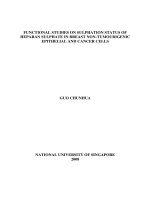Studies on machine learning for data analytics in business application
Bạn đang xem bản rút gọn của tài liệu. Xem và tải ngay bản đầy đủ của tài liệu tại đây (1.28 MB, 114 trang )
STUDIES ON MACHINE LEARNING FOR DATA
ANALYTICS IN BUSINESS APPLICATION
FANG FANG
(B.Mgmt.(Hons.), Wuhan University)
A THESIS SUBMITTED
FOR THE DEGREE OF DOCTOR OF PHILOSOPHY
DEPARTMENT OF INFORMATION SYSTEMS
NATIONAL UNIVERSITY OF SINGAPORE
2014
I
DECLARATION
I hereby declare that the thesis is my original work and it has been written by me in its
entirety. I have duly acknowledged all the sources of information which have been used
in the thesis.
This thesis has also not been submitted for any degree in any university previously.
_________________________
Fang Fang
22 January 2014
II
ACKNOWLEDGEMENTS
I would like to thank many people who made this thesis possible.
First and foremost, it is difficult to overstate my sincere gratitude to my supervisor,
Professor Anindya Datta. I appreciate all his contributions to my research, as well as his
guidance and support in both my professional and personal time. It has been a great honor
to work with him. I am also deeply indebted to Professor Kaushik Dutta, who has
provided great encouragement and sound advice throughout my research journey.
I thank my fellow students and friends in NUS, especially members of the NRICH group,
for providing such a warm and fun environment in which to learn and grow. I will never
forget our stimulating discussions, our time when working together, and all the fun we
have had.
Last but not least, I would like to thank my parents, for the unconditional support and
love. To them I dedicate this thesis.
III
TABLE OF CONTENTS
CHAPTER 1 INTRODUCTION 1
1.1 BACKGROUND AND MOTIVATION 1
1.2 RESEARCH FOCUS AND POTENTIAL CONTRIBUTIONS 4
1.2.1 Study I: Cross-domain Sentimental Classification 4
1.2.2 Study II: LDA-Based Industry Classification 5
1.2.3 Study III: Mobile App Download Estimation 6
1.3 MACHINE LEARNING 7
1.4 THESIS ORGANIZATION 8
CHAPTER 2 STUDY I: CROSS-DOMAIN SENTIMENTAL CLASSIFICATION
USING MULTIPLE SOURCES 9
2.1 INTRODUCTION 9
2.2 RELATED WORK 12
2.2.1 In-domain Sentiment Classification 12
2.2.2 Cross-domain Sentiment Classification 14
2.2.3 Other Sentiment Analysis Tasks 18
2.3 SOLUTION OVERVIEW 18
IV
2.4 SOLUTION DETAILS 20
2.4.1 System Architecture 21
2.4.2 Preprocessing 21
2.4.3 Source Domain Selection 23
2.4.4 Feature Construction 24
2.4.5 Classification 29
2.5 EVALUATION 29
2.5.1 Experimental Setting 30
2.5.2 Evaluation Metrics 32
2.5.3 Single Domain Method 33
2.5.4 Multiple Domains Method 36
2.6 CONTRIBUTIONS AND LIMITATIONS 44
2.7 CONCLUSION AND FUTURE DIRECTIONS 45
CHAPTER 3 STUDY II: LDA-BASED INDUSTRY CLASSIFICATION 46
3.1 INTRODUCTION 46
3.2 RELATED WORK 49
3.2.1 Industry Classification 49
V
3.2.2 Peer Firm Identification 50
3.3 SOLUTION OVERVIEW 52
3.4 SOLUTION DETAILS 55
3.4.1 Architecture 56
3.4.2 Representation Construction 57
3.4.2 Industry Classification 60
3.5 EVALUATION 63
3.5.1 Experimental Setting 63
3.5.2 Evaluation Metrics 64
3.5.3 Evaluation Results 64
3.6 CONTRIBUTIONS AND LIMITATIONS 68
3.7 CONCLUSION AND FUTURE RESEARCH 69
CHAPTER 4 STUDY III: MOBILE APPLICATIONS DOWNLOAD ESTIMATION . 71
4.1 INTRODUCTION 71
4.2 RELATED WORK 74
4.3 MODEL 76
4.3.1 Overview 76
VI
4.3.2 Rank 77
4.3.3 Time Effect 80
4.4 MODEL ESTIMATION 81
4.4.1 Direct Estimation 81
4.4.2 Indirect Estimation 82
4.5 EVALUATION 84
4.5.1 Data Set 84
4.5.2 Estimation Results 87
4.5.3 Estimation Accuracy 89
4.6 LIMITATIONS AND FUTURE DICECTIONS 93
4.7 CONCLUSION 93
CHAPTER 5 CONCLUSION 95
REFERENCE 97
VII
SUMMARY
The volume of data produced by the digital world is now growing at an unprecedented
rate. Data are being produced everywhere, from Facebook, Twitter, YouTube to Google
search records, and more recently, mobile apps. The tremendous amount of data
embodies incredible valuable information. Analysis of data, both structured and
unstructured such as text, is important and useful to a number of groups of people such as
marketers, retailers, investors, and consumers.
In this thesis, we focus on predictive analytics problems in the context of business
applications and utilize machine learning methods to solve them. Specifically, we focus
on 3 problems that can support a firm’s business and management team’s decision-
making. We follow the Design Science Research Methodology (Hevner and Chatterjee
2010, Hevner et al. 2004) to conduct the studies.
Study I (chapter 2) focuses on cross-domain sentimental classification. Sentiment
analysis is quite useful to consumers, marketers, and organizations. One of the tasks of
sentiment analysis is to determine the overall sentiment orientation of a piece of text.
Supervised learning methods, which require labeled data for training, have been proven
quite effective to solve this problem. One assumption of supervised methods is that the
training domain and the data domain share exactly the same distribution, otherwise,
accuracy drops dramatically. However, in some circumstances, labeled data is quite
expensive to acquire. For instance, Tweets and comments in Facebook. Study I addresses
this problem and proposes an approach to determine the sentiment orientation of a piece
VIII
of text when in-domain labeled data is not available. The experimental results suggest
that the proposed method outperforms all existing methods in literature.
Study II (chapter 3) focuses on Industry Classification. Industry analysis, which studies a
specific branch of manufacturing, service, or trade, is quite useful for various groups of
people. Before industry analysis, we need to define industry boundaries effectively and
accurately. Existing schemes like SIC, GICS or NAICS have two major limitations.
Firstly, they are all static and assume that the industry structure is stable. Secondly, these
schemes assume binary relationship and do not measure the degree of similarity. Study II
aims to contribute the literature by proposing an industry classification methodology that
can overcome these limitations. Our method is on the basis of business commonalities
using the topic features learned by the Latent Dirichlet Allocation (LDA) from firms’
business descriptions.The experimental results indicate that the proposed approach is
better than the GICS and the baseline.
Study III (chapter 4) focuses on mobile app download estimation. Mobile apps represent
the fastest growing consumer product segment of all times. To be successful, an app
needs to be popular. The most commonly used measure of app popularity is the number
of times it has been downloaded. For a paid app, the downloads will determine the
revenue the app generates; for an ad-driven app, the downloads will determine the price
of advertising on this app. In addition, research in the app market necessities download
numbers to measure the success of an app. Even though the app downloads are quite
valuable, it turns out that number of downloads is one of the most closely guarded secrets
in the mobile industry – only the native store knows the download number of an app.
IX
Study III intends to propose a model of daily free app downloads estimation. The
experimental results prove the effectiveness and accuracy of the proposed model.
X
LIST OF TABLES
Table 2.1 Data Statistics 30
Table 2.2 Parameter Range 31
Table 2.3 Domain Similarity 33
Table 2.4 Classification Accuracy using Single Source Domain 34
Table 2.5 P-values of Accuracy Significant Test for ISSD method 35
Table 2.6 Transfer Loss using Single Source Domain 36
Table 2.7 Classification Accuracy 37
Table 2.8 P-values of Accuracy Significant Test for MSD method 39
Table 2.9 Transfer Loss 42
Table 3.1 Average Adjusted
across Methods for FCIC 65
Table 3.2 Average Adjusted
across Methods for ICIC 67
Table 3.3 Top 5 Firms in Payment Industry in 2011 68
Table 3.4 Top 5 Firms in Mass Media Industry in 2010 68
Table 4.1 Descriptive Statistics of the Training Data I 85
Table 4.2 Descriptive Statistics of the Training Data II 86
Table 4.3 Descriptive Statistics of the Testing Data 87
Table 4.4 Model Estimation Results for iPhone Apps 88
Table 4.5 Model Estimation Results for iPad Apps 89
Table 4.6 Estimation Error 90
XI
LIST OF FIGURES
Figure 2.1 System Architecture 21
Figure 2.2 A RBM with 3 hidden units and 4 visible units 25
Figure 2.3 Accuracy Curve 41
Figure 2.4 Transfer Loss Curve 43
Figure 2.5 Transfer Loss across Methods 44
Figure 3.1 System Architecture 56
Figure 3.2 Plate Notation of a smoothed LDA 58
Figure 3.3 Top 10 Peers of Dow Chemical in 2009 66
Figure 3.4 Top 10 Peers of Google Inc. in 2011 67
Figure 4.1 Estimation Error Distribution 91
1
CHAPTER 1 INTRODUCTION
1.1 BACKGROUND AND MOTIVATION
The volume of data produced by consumer activity is growing at an unprecedented rate.
Data are being produced everywhere, from Facebook, Twitter, YouTube to Google
search records, and more recently, mobile apps. According to recent research by
International Data Corporation (IDC)
1
, digital data that can be analyzed by computers
will double about every two years from now until 2020 (Gantz and Reinsel 2012). IDC’s
report estimates that there will be 40,000 exabytes, or 40 trillion gigabytes, of digital data
in 2020. Without doubt, the amount of data is huge.
The tremendous amount of data encapsulates much useful information. Analysis of this
data, both structured and unstructured, is quite valuable and useful to various
constituencies in the business community and critical for business success: (a) Marketers
need to use customer profile data to differentiate among customers and then match
customers with appropriate product offerings; (b) Retailers need to use transaction data to
monitor the sales trends and then optimize inventory. (c) Investors need to use financial
statement data to investigate company’s competitiveness and then make investment
decisions; (d) Consumers need to use text review data to research products and then make
the final purchase. In a word, data analytics is extremely valuable.
1
2
Data analytics may be classified into several categories: (1) descriptive analytics aims to
provide descriptive statistics of data such as mean, average and so on; (2) explanatory
analytics intends to use statistical methods to explain observed phenomena and explore
causal relationships (Shmueli and Koppius 2011); (3) predictive analytics aims to use
various machine learning techniques for forecasting future or unknown events. In this
dissertation, we focus on applying predictive analytics methods to common business
problems. Our motivation stems from the ubiquity of "predictive" problems in the
business domain, but the relative paucity of work on applying predictive analytics
techniques in this area. We explain this below.
The need to predict future events is paramount in many business scenarios: (a) revenue
and profit forecasting, (b) predicting/classifying consumer types that would be interested
in particular product lines, (c) predicting competitor actions and (d) predicting market
reaction to new products, to just name a few. Given the abundance of situations needing
"smart" predictions, it would appear that traditional machine learning predictive
techniques would be a natural fit.
Machine learning has been extensively applied in a number of domains, mostly Science
and Engineering areas such as Bioinformatics (Michiels et al. 2005, Tarca et al. 2007),
Cheminformatics (Gehrke et al. 2008, Podolyan et al. 2010), Robotics (Conrad and
DeSouza 2010) and so on. However, far less work has been done in business-related
areas. In particular, in certain areas like Industry Classification, there is very little work
which uses machine learning to address the problem. Recently, there is increasing
research interest in the application of machine learning methods for business analytics
3
(Abbasi and Chen 2008, Rui and Whinston 2011) and results are promising. However,
much more needs to be done.
In this thesis, we focus on predictive analytics problems in the context of business
applications and utilize machine learning methods to solve them. In particular, we look at
three classes of business problems that can support a firm’s business and management
team’s decision-making: (1) extracting sentiments expressed by users towards products:
the management team is always eager to know how products are received by the
consumers and then modify the production plan accordingly. We fulfill this need by using
the reviews text data written by consumers and extract their attitude towards the products.
(2) Industry classification: The management team also likes to identify who the
competitors are and adjust the company’s business strategy accordingly. We contribute to
this by using firms’ 10-K forms and identifying firms involved in same business, which
are therefore potentially competitors, and (3) Competitor Sales Estimation: The
management team is also interested in the sales of products from other competitors so as
to then adjust their product strategy accordingly. To know the exact sales volume of
competitors by product line is quite hard, given the sensitivity of the data. In this thesis,
we provide a solution in the mobile app domain due to the availability of data and use
sale ranks to estimate the actual sales amount. The three problems chosen are due to their
wide application in multiple business scenarios, and of course, each of these problems
has received much attention lately in the literature. A brief introduction of the three
problems is presented in the next section.
4
1.2 RESEARCH FOCUS AND POTENTIAL CONTRIBUTIONS
In this section, we will briefly introduce the research problems investigated in the thesis
and also discuss potential contributions of each study. The first two studies use text data
for analytics: study I aims to detect sentimental orientation embedded in the text and
study II aims to classify firms into industries based on text descriptions of firms’ business.
Study III aims to estimate the sales of products. We select the domain of mobile apps due
to the availability of data. In this thesis, we follow the Design Science Research
Methodology (Hevner and Chatterjee 2010, Hevner et al. 2004) to conduct the studies.
1.2.1 Study I: Cross-domain Sentimental Classification
Sentiment analysis, which aims to detect the underlying sentiments embedded in texts,
has attracted much research interest recently. Such sentiments are quite useful to
consumers, marketers, organizations, etc. One of the tasks of sentiment analysis is to
determine the overall sentiment orientation of a piece of text and supervised learning
methods, which require labeled data for training, have been proven quite effective to
solve this problem.
One assumption of supervised methods is that the training domain and the data domain
share exactly the same distribution, i.e., (a) texts in both data sets are represented in same
feature space and (b) features, or words, follow the same distributions in both data sets.
The first assumption requires that a similar set of words are used in both domains, while
the second assumption demands that the occurrence probability of a word is identical in
training and testing domains. If these assumptions do not hold, accuracy drops
5
dramatically (about 10% according to our experiment results). These assumptions do not
pose problems when performing sentiment analysis in domains where training data are
readily available.
However, in some circumstances, labeled data is quite expensive to acquire. For instance,
if we want to detect sentiment from Tweets or comments in Facebook, the only way to
get labeled data is by manually labeling and thus, it is prohibitively burdensome and
time-consuming.
This is the problem addressed in this study - we want to determine the sentiment
orientation of a piece of text when in-domain labeled data is not available. Particularly,
we would like to contribute the literature by proposing an innovative method that can
effectively perform cross-domain sentimental classification.
1.2.2 Study II: LDA-Based Industry Classification
Industry analysis, which studies a specific branch of manufacturing, service, or trade, is
quite useful for various groups of people: asset managers, credit analysts, investors,
researchers, etc. Before industry analysis, we need to define industry boundaries
effectively and accurately. Otherwise, further industry analysis could become impossible,
or at least misleading.
6
There exist a number of Industry Classification schemes such as the Standard Industrial
Classification (SIC)
2
and the North American Industry Classification System (NAICS)
3
.
However, these schemes have two major limitations. Firstly, they are all static and
assume that the industry structure is stable (Hoberg and Phillips 2013). Secondly, these
schemes assume binary relationship and do not measure the degree of similarity.
In this study, we aim to contribute the literature by proposing an industry classification
methodology that can overcome these limitations. Our method is on the basis of business
commonalities using the topic features learned by the Latent Dirichlet Allocation (LDA)
(Blei et al. 2003) from firms’ business descriptions.
1.2.3 Study III: Mobile App Download Estimation
Mobile apps represent the fastest growing consumer product segment of all time (Kim
2012). The production scale of apps is eye-popping as well – approximately 15000 new
apps are launched every week (Datta et al. 2012). To be successful, an app needs to be
popular. The most commonly used measure of app popularity is the number of times
(which we will simply refer to as “downloads”) it has been downloaded into consumers’
smart-devices. For a paid app, the downloads will determine the revenue the app
generates; for an ad-driven app, the downloads will determine the price of advertising on
this app. In addition to its huge business value, app download numbers are also quite
valuable from a research perspective. The rapid growth of the app market offers an
2
[Accessed May 1, 2013]
3
[Accessed May 1, 2013]
7
excellent place for studies such as innovation (Boudreau 2011), competitive strategies in
hypercompetitive markets (Kajanan et al. 2012). Studies in the app market necessities
download numbers to measure the success of an app.
Even though app downloads are quite valuable, it turns out that number of downloads is
one of the most closely guarded secrets in the mobile industry – only the native store
knows the download number of an app. As a result, in recent times, there has been much
interest in estimating app downloads (Garg and Telang 2012). However, the present study
only focuses on paid apps. In this study, we intend to fill the gap by proposing a model
for estimating daily free app downloads, which complements Garg and Telang (2012).
1.3 MACHINE LEARNING
Machine learning is a highly interdisciplinary field which borrows and builds upon ideas
from statistics, computer science, engineering, cognitive science, optimization theory and
many other disciplines of science and mathematics (Ghahramani 2004). It aims to
construct computer programs/systems that can make decisions regarding unseen instances
based on knowledge learnt from the training data. Tom Mitchell provided a widely
quoted formal definition: “A computer program is said to learn from experience E with
respect to some class of tasks T and performance measure P, if its performance at tasks in
T, as measured by P, improves with experience E” (Mitchell 1997).
Machine learning methods can be categorized into several classes and two major types
are supervised learning methods and unsupervised learning methods. Supervised methods
require correct outputs for instances in training data, and their objective is to learn a
8
function from the training data, which can produce a output for instances not in the
training data. The output can be a class label for classification tasks and a real number for
regression tasks. On the contrary, unsupervised methods do not require instances in
training data to have correct outputs, and their purpose is to identify underlying patterns
in the training data. One classic example of unsupervised learning is clustering, which
aims to group similar instances as a cluster. Another example is topic models, such as the
Latent Dirichlet Allocation (LDA) (Blei et al. 2003), whose goal is to discover
underlying “topics” in a collection of documents.
Both supervised methods and unsupervised methods are used in this thesis. Specifically,
supervised methods are used for cross-domain sentimental classification (study I) and
mobile app downloads estimation (study III); unsupervised methods are used for industry
classification (study II).
1.4 THESIS ORGANIZATION
The rest of this thesis is organized as follows: chapter 2 presents the study on cross-
domain sentiment classification. In chapter 3, we propose a novel method for industry
classification and peer identification. Chapter 4 discusses the estimation of mobile app
downloads using rankings. Chapter 5 concludes this thesis.
9
CHAPTER 2 STUDY I: CROSS-DOMAIN
SENTIMENTAL CLASSIFICATION USING
MULTIPLE SOURCES
2.1 INTRODUCTION
With the explosion of blogs, social networks, reviews, ratings as well as other user-
generated texts, sentiment analysis, which aims to detect the underlying sentiments
embedded in those texts, has attracted much research interest recently. Such sentiments
are useful to various constituencies: (a) Consumers can use sentiment analysis to research
products or services before making a purchase. (b) Marketers can use this to research
public opinion regarding their company and products, or to analyze customer satisfaction.
Finally, (c) organizations can also use this to gather critical feedback about problems in
newly released products.
One of the tasks of sentiment analysis is to determine the overall sentiment orientation of
a piece of text. This problem has been widely investigated and supervised learning
methods, which require labeled data for training, have been proven quite effective.
However, supervised methods assume that the training data domain and the testing data
domain share exactly the same distribution, i.e., (a) texts in both data sets are represented
in same feature space and (b) features, or words, follow the same distributions in both
data sets. The first assumption requires that a similar set of words are used in both
domains, while the second assumption demands that the occurrence probability of a word
10
is identical in training and testing domains. If these assumptions do not hold, accuracy
drops dramatically (about 10% according to our experiment results). These assumptions
do not pose problems when performing sentiment analysis in domains where training data
are readily available. An example of such a domain is movie reviews. Each review is
typically accompanied by a numerical rating, allowing easy assignment of sentiment to
the review. In nearly all previous work, reviews rated 1 and 2 are considered as negative
and those rated 4 and 5 are treated as positive. However, in circumstances where user-
assigned ratings are not available, labeled data is quite expensive to acquire. For instance,
if we want to detect sentiment from Tweets or comments in Facebook, the only way to
get labeled data is to manually label it and thus, prohibitively burdensome and time-
consuming. Yet, sentiment mining is pervasive enough such that its application is useful
in many domains, such as Tweets and Facebook comments, where labeled data are not
available.
This is the problem addressed in this study. We want to determine the sentiment
orientation of a piece of text when in-domain labeled data is not available. A number of
methods have been proposed in the literature most of which rely on the idea of applying
labeled data from a “source” domain to perform sentiment classification on data in a
different “target” domain through domain independent feature called pivot features.
Following is an illustrative example. Suppose we are adapting from “computers” domain
to “cell phones” domain. While many of the features of a good cell phone review are the
same as a computer review, such as “excellent” and “awful”, many words are totally new,
like “reception”. In addition, many features which are useful for computers, for instance
“dual-core”, are not useful for cell phones. The intuition is that even though the phrase
11
“good-quality reception” and “fast dual-core” are completely distinct for each domain,
they both have high correlation with “excellent” and low correlation with “awful” on
unlabeled data. As a result, we can tentatively align them (Blitzer et al. 2007). After
learning a classifier for computer reviews, when we see a cell-phone feature like “good-
quality reception”, we know it should behave in a roughly similar manner to “fast dual-
core”.
The main drawback of these methods is that the performance is largely dependent on the
selection of pivot features. Ideally, pivot features would act similarly in both target and
source domains towards sentiment. The problem is that we do not know the sentiment of
the data in the target domain, making extremely hard to select those pivot features
accurately.
In this study, we propose a hybrid approach that integrates the sentiment information
from labeled data of multiple source domains and a set of preselected sentiment words for
sentimental domain adaptation, i.e., cross-domain sentiment classification. In order to
solve the aforementioned limitation caused by difficulty of pivot feature selection, we
tackle this task by mapping the data into a latent space to learn an abstract representation
of the text. The assumption we make is that texts with the same sentiment label would
have similar abstract representations, even though their text representations differ. For
instance, in the previous example, the phrase “good-quality reception” and “fast dual-
core” are completely distinct for each domain; however, in the latent space, they might
corresponds to the same feature. This idea has been used in Titov (2011) and Glorot et al
(2011); however, as we will discuss later, our method is distinct enough from them.
12
Furthermore, in addition to use of out-domain data, we also utilize sentiment information
from preselected opinionated words. We believe these words could provide certain
helpful sentiment information in our classification context. Finally we train our classifiers
over the new hybrid representations. The experimental results suggest that our method
statistically outperforms the state of the art and even surpasses the in-domain method in
some cases.
The rest of the chapter is organized as follows: we first review related work in literature.
Then we provide the intuition and overview of our method followed by an elaboration of
our proposed method. Whereafter, we evaluate our method on a benchmark data set.
Finally, we conclude this chapter with a discussion of this study.
2.2 RELATED WORK
In this section, we review related work on in-domain sentiment classification, cross-
domain sentiment classification as well as other sentiment analysis tasks.
2.2.1 In-domain Sentiment Classification
One of the most thoroughly studied problems in sentiment analysis is the in-domain
sentiment classification, which refers to the process of determining the overall tonality of
a piece of text and classifying it into several sentiment classes. Two main research
directions have been explored, i.e., document level sentiment classification and sentence
level sentiment classification.
In document level classification, documents are assumed to be opinionated and all
documents are classified as either positive or negative (Liu 2010). This problem can be
13
addressed as either supervised learning problem or unsupervised classification problem.
Many of the existing research using supervised machine learning approach have used
product reviews as target documents. Training and testing data are very convenient to
collect for these documents since each review already has a reviewer-assigned rating,
typically 1-5 stars. One representative work would be (Pang and Lee 2008). They
employed multiple approaches to the sentiment classification problem and concluded that
machine learning methods definitively outperform others.
Due to opinion words being the dominating indicators for sentiment classification, it is
quite natural to use unsupervised learning based on such words. This kind of methods has
not been studied so much because of its relatively inferior performance compared with
supervised methods. The simplest method is to determine sentiment of a document based
on the occurrences of positive and negative word. A review could be classified as
positive if there are more positive words and categorized as negative otherwise. One
representative example the more sophisticated work is Turney (2002). They performed
classification based on certain fixed syntactic phrases that are likely to be used to express
opinion. They first identified phrases with positive semantic orientation and phrases with
negative semantic orientation. The semantic orientation of a phrase was calculated as the
mutual information between the given phrase and the word “excellent” minus the mutual
information between the given phrase and the word “poor”. A review was classified as
positive if the average semantic orientation of its phrases is positive and categorized as
negative otherwise.
